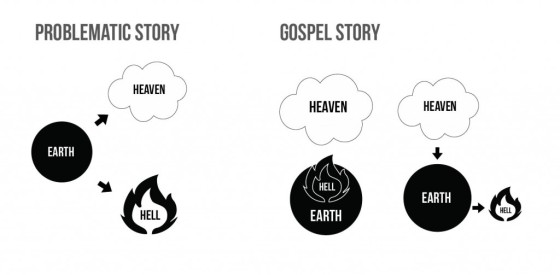A few months ago I chose a passage in Matthew 13 to speak on this past Sunday. The parable of the weeds highlights living with evil (righteousness and evil growing in the same soil), even though evil will, in the end, be thrown into the eternal fire.
As events in Baton Rouge, then Minneapolis, then Dallas, then Nice, France took place, it seemed all the more poignant to consider how Christ followers live in light of an evil world. While facing evil some want to run to doomsday theology, forgetting the fact that for the Christian, fear is a liar. I think there’s a decidedly different approach that Bible presents, in light of the gospel.
The Protection of Hell
In his book The Skeletons in God’s Closet, Joshua Ryan Butler rightly points out the common reference to “hell” in the Bible is a physical place known as the Valley of Hinnom. Evil, having no place in heaven, is thrown outside the city gates, to a place where idolatry and injustice can reign as they light their own fires. Here’s a diagram he uses to describe heaven and earth’s relation to hell:
On the left we have the problematic understanding of heaven and earth and hell. In this we see ourselves on earth, and from earth we either go to heaven or hell for eternity. But this is not what the Bible says about earth’s relationship to heaven.
In the Gospel story the Bible presents earth is full of hell and it’s evil, but upon the return of Jesus, heaven comes down to earth, and hell is banished outside of the walls of this new earth, this new Jerusalem, the city of God. God excludes sin, evil, hell, from his kingdom because of his goodness, for the sake of protecting what is good.
We see this within the book of Revelation, during the climactic end of the Bible story. God, with the 2nd coming of Christ, brings down the new Jerusalem, down from heaven to earth. From this capital city, God’s ruling, reigning, restorative power goes out into all of the world, the holy city standing at the center of all of it, as all things are made new.
It is this New Jerusalem which stands in contrast to gehenna, hell, the valley of Hinnom. As Butler says, “Through the new Jerusalem, we see God’s posture as one of welcoming embrace, but sin and her allies are never allowed to enter inside the city gates: ‘Nothing impure will ever enter it, nor will anyone who does what is shameful or deceitful (Revelation 21:27).'”
Fear is Everywhere
What does this have to do with evil in today’s world?
Well, everything actually. Check out Colossians 2:15, where Paul writes, “And having disarmed the powers and authorities, he made a public spectacle of them, triumphing over them by the cross.” Christ has exposed evil for what it is, triumphing over it, and evil is soon to be cast outside of the holy dwelling of God with his people.
Therefore, there’s nothing to fear.
Fear has a stranglehold on the world today. Politicians are turning fear into a commodity for the sake of votes. Every day a new headline appears that can cause your life to go into a tailspin. Yet the Christian believer has nothing to fear. Nothing.
The most frequently stated command in the entire Bible is “do not be afraid.” This doesn’t even include variations of that phrase. Do not be afraid. Why? How? Because believers are eternally protected by the fire of God’s holy love for his children (Zechariah 2:5).
When the Messiah is born and the earthly king sends soldiers to kill him…do not be afraid.
When an entire town is furious enough to push the Messiah off of a cliff…do not be afraid.
When the ruler of the free world is targeting Christians and killing their leaders…do not be afraid.
When fear and violence overtake the headlines all over the world…do not be afraid.
In the face of unrest and violence, with fear winning the battle over society, Christians must be a stabilizing force of hope, pointing people to the light shining out of the darkness.

